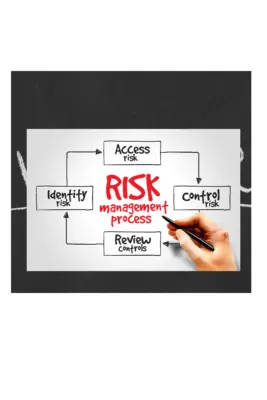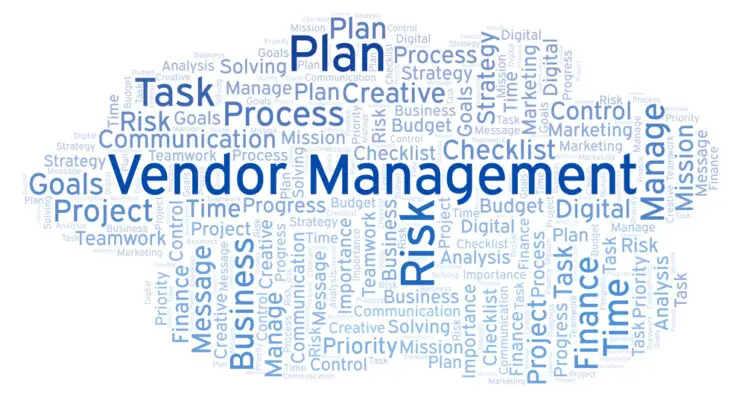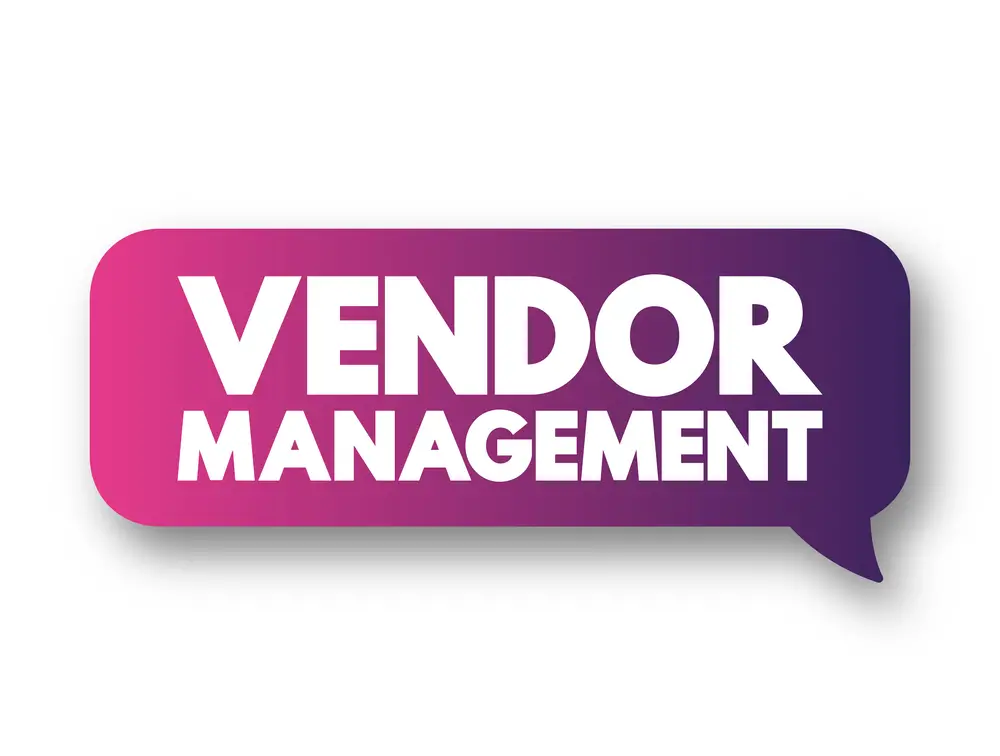A vendor risk assessment is essential for enhancing security, vendor relations, threat adaptation, legal risk reduction, and proactive risk management culture.
This tool evaluates risks linked to vendors, enhancing risk strategies, preventing breaches, and identifying vulnerabilities for preemptive actions.
Vendor risks are diverse and can originate from various sources including operational, compliance, cybersecurity, and reputational factors.
A comprehensive vendor risk assessment process ensures that all potential risks are identified and appropriately managed throughout the vendor lifecycle.
It is crucial to consider direct risks and the broader implications of third-party relationships on the organization’s overall risk profile.
Conduct assessments regularly, integrate into vendor lifecycle management, and address risks promptly. Criteria encompass data security, financial stability, compliance, and operational reliability, tailored for specifics.

Follow a structured assessment process, prioritize critical vendors, understand risk tolerance, and align with organizational goals.
The assessment is key to meeting compliance, ensuring security, and building strong vendor relationships. Discover more benefits and tips for effective vendor risk management.
Key Takeaways
- Comprehensive risk assessment enhances compliance and reduces costs.
- Regularly update assessments for effective risk management.
- Prioritize critical vendors to focus on high-risk areas.
- Adapt assessments to changing vendor landscapes.
- Ensure vendors meet regulatory standards for risk mitigation.
Basics of Vendor Risk Assessment
When conducting a vendor risk assessment, organizations can benefit from:
- Identifying potential risks associated with third-party vendors.
- Implementing Vendor Lifecycle Management practices.
- Selecting appropriate assessment criteria.
Understanding when to conduct a vendor risk assessment and employing effective risk identification methods are important in enhancing security measures and mitigating operational risks within the vendor ecosystem.
What are the benefits of a vendor risk assessment?
Vendor risk assessments offer organizations a strategic advantage by proactively identifying and mitigating potential risks associated with third-party vendors.
These assessments are important in risk management and compliance, as they evaluate vendors’ security controls, financial stability, and regulation adherence.
By conducting vendor risk assessments, organizations can prevent data breaches, service disruptions, and legal issues, ultimately reducing costs associated with security incidents.
Additionally, these assessments help identify vulnerabilities and implement proactive measures to minimize risks, ensuring operational excellence and safeguarding the organization’s reputation.
- Enhances risk management and compliance efforts
- Reduces costs by preventing data breaches and legal issues
- Identifies vulnerabilities for proactive risk mitigation
- Safeguards operational excellence and reputational risk assessments
What is Vendor Lifecycle Management?
Throughout the engagement with an organization, Vendor Lifecycle Management involves evaluating and managing vendor risks.
This process examines vendor operations, security controls, financial stability, compliance, and performance over the vendor lifecycle.
Organizations can make informed decisions regarding vendor selection, risk mitigation strategies, and ongoing monitoring efforts by actively engaging in Vendor Lifecycle Management.
Effectively implementing Vendor Lifecycle Management practices helps reduce the potential impact of vendor-related risks on the organization.
It also enhances overall risk management strategies and fosters a more secure vendor relationship.
Prioritizing Vendor Lifecycle Management ensures businesses can proactively address risks and maintain a robust vendor ecosystem, safeguarding against potential threats.
When should you conduct a vendor risk assessment?
Periodic assessment of vendor risks is essential for effective risk management and proactive mitigation within organizations.
- Including vendor risk assessments in the Request for Proposal (RFP) process can help avoid and mitigate risk.
- Regular evaluation of risks throughout the vendor lifecycle is vital for maintaining a secure vendor ecosystem.
- Conducting a fresh vendor risk assessment when a risk event occurs can assist in promptly implementing preventive measures.
- The frequency of updates for vendor risk assessments should be based on the importance and risk probability of the vendor in question.
Risk Identification Methods
Regularly reviewing and analyzing different risk identification methods is essential to conducting a thorough vendor risk assessment.
Qualitative risk assessment involves describing and characterizing risks without numerical measurements.
In contrast, quantitative risk assessment uses numerical data to quantify the likelihood of events. Semi-quantitative risk assessment combines qualitative and quantitative approaches for a more thorough evaluation.
Ongoing vendor risk reviews are vital for continuously assessing and managing risks associated with third-party vendors.
Understanding various risk assessment methods is key to effectively identifying, evaluating, and managing risks in the vendor ecosystem.
This holistic approach guarantees a robust management of risks and enables organizations to evaluate their vendor relationships thoroughly.

Assessment Criteria Selection
Understanding the importance of selecting appropriate assessment criteria is fundamental to conducting a thorough vendor risk evaluation. This is especially crucial when evaluating factors such as data security, financial stability, regulatory compliance, and operational reliability.
When choosing assessment criteria, consider the following:
- Data security measures implemented by the vendor
- Vendor’s financial stability and creditworthiness
- Adherence to regulatory requirements and compliance standards
- Reliability of the vendor’s operational infrastructure
These criteria help evaluate the vendor’s IT infrastructure, legal compliance, and performance impact on business operations.
Tailoring evaluation criteria to specific vendor types and utilizing standardized templates ensure a consistent and in-depth evaluation of potential vendor risks.
Mitigation Strategy Development
In crafting an effective mitigation strategy for vendor risk assessment, the focus lies on developing targeted plans to reduce the impact of identified risks and bolster resilience against potential threats.
Mitigation strategies are pivotal in addressing specific vulnerabilities and threats associated with vendors, aiming to enhance preparedness, response, and recovery capabilities in the face of potential risks.
Organizations can proactively manage risks in vendor relationships by outlining actions and measures to minimize the likelihood of risks materializing.
Effective mitigation strategies help reduce the impact of identified risks and contribute to a more secure vendor ecosystem. The table below provides a visual representation of key elements in mitigation strategy development:
| Elements | Description | Importance |
|---|---|---|
| Vulnerabilities | Identifying weak points | High |
| Threats | Potential risks | Critical |
| Preparedness | Readiness for risks | Essential |
| Response | Timely reaction | Vital |
Creating a Vendor Risk Assessment
When developing a vendor risk assessment, it is essential to focus on five key aspects:
- Conducting effective assessments
- Performing the assessment process accurately
- Identifying critical assets and vendors
- Determining risk tolerance
- Generating security ratings
These points form the foundation for thoroughly evaluating vendor risks, helping organizations make informed decisions and strengthen their overall risk management strategies.
Five Keys to Conducting Effective Vendor Risk Assessments
Organizations must meticulously analyze their third-party vendors’ vulnerabilities, security controls, policies, and procedures to conduct effective vendor risk assessments and create a robust vendor risk assessment process. When focusing on conducting these assessments, there are key factors to contemplate:
- Categorizing Vendors: Assign risk profiles and scores to categorize vendors effectively.
- Effective Communication: Promote clear communication with vendors to address risks.
- Continuous Monitoring: Implement systems for ongoing monitoring of vendor activities.
- Senior Management Involvement: Guarantee senior management actively engages in the assessment process.
These elements contribute to developing thorough risk mitigation strategies, essential for safeguarding against data breaches, ensuring regulatory compliance, and minimizing operational risks.
How to perform the vendor risk assessment process
Developing a thorough vendor risk assessment process is imperative for organizations aiming to manage and mitigate potential risks associated with third-party vendors proactively.
Organizations should utilize a vendor risk assessment questionnaire focusing on critical areas such as data security, compliance, financial stability, reputation, and IT infrastructure to create a robust vendor risk assessment.
Analyzing vendor risk profiles through security practices, financial reports, audit results, and compliance certifications helps understand risk exposure.
Categorizing vendors based on risk profiles and assigning scores enables effective prioritization of risk mitigation efforts.

Creating risk mitigation strategies involves implementing security controls and establishing performance metrics to address identified risks.
| Vendor Risk Assessment Process |
|---|
| Vendor Risk Assessment Questionnaire |
| Vendor Risk Profiles |
| Risk Mitigation Strategies |
| Security Controls |
Identify critical assets and vendors
To efficiently create a Vendor Risk Assessment that effectively identifies critical assets and vendors, organizations should first focus on categorizing vendors based on their relationship to critical assets and evaluating the associated risks they may pose.
- Conduct impact assessments to understand the significance of vendor services/products on critical assets.
- Categorize vendors according to the level of risk they represent to critical assets.
- Prioritize risk assessment based on asset criticality and potential vendor-related risks.
- Develop a thorough strategy by mapping critical assets to specific vendors for a detailed risk assessment approach.
Determine risk tolerance and appetite.
Understanding the organization’s risk tolerance and appetite is an essential initial step in crafting a thorough Vendor Risk Assessment that aligns with strategic risk management objectives.
Risk tolerance involves determining the level of risk acceptable in vendor relationships, while risk appetite defines the amount of risk the company is willing to undertake to achieve its goals.
Evaluating risk tolerance aids in establishing effective risk management strategies and controls within vendor risk assessments.
Additionally, grasping risk appetite plays a significant role in decision-making regarding vendor selection and implementing risk mitigation measures.
Generate security ratings
One essential aspect of creating a Vendor Risk Assessment is the generation of security ratings to evaluate the security posture of third-party vendors.
Security ratings play a vital role in vendor risk assessments by quantitatively measuring vendor security controls and vulnerabilities.
When generating security ratings, organizations typically consider factors such as data encryption, access controls, incident response procedures, and compliance measures.
These ratings help prioritize vendors based on their security risk levels and enable informed decision-making regarding vendor selection and risk mitigation strategies.
- Evaluate vendor security controls effectively.
- Quantitatively measure vendor security posture.
- Prioritize vendors based on security risk levels.
- Develop risk mitigation strategies for vendors.
Define Your Acceptable Level of Residual Risk
When establishing a Vendor Risk Assessment, it is crucial to clearly define the acceptable level of residual risk to manage potential risks associated with third-party vendors effectively.
Residual risk, the level of risk that remains after implementing mitigation strategies, must be assessed to set clear risk tolerance thresholds within organizations.
This definition guarantees that risks are managed within predefined limits, aligning with business objectives and aiding in vendor selection and decision-making regarding risk management strategies.
Sample Vendor Risk Assessment Templates
A well-crafted Vendor Risk Assessment Template is a foundational tool for systematically evaluating and managing risks associated with third-party vendors.
When utilizing sample templates, organizations can guarantee a consistent approach to evaluating vendor risks, covering essential factors such as data security, regulatory compliance, and performance metrics.
These templates facilitate a comprehensive evaluation process, enabling businesses to effectively pinpoint vulnerabilities and areas of concern.
Companies can tailor their risk assessment process to address evolving threats and changing requirements by customizing templates based on specific business needs.
The structured format provided by these templates streamlines the evaluation of third-party vendors, enhancing the overall efficiency of risk management practices.
- Guarantees consistency in risk evaluation processes
- Facilitates thorough evaluation of vendor risks
- Helps pinpoint potential vulnerabilities and areas of concern
- Allows customization based on business needs
Best Practices for Vendor Risk Assessment
- Integration with Broader ERM Frameworks: Vendor risk management should be integrated into the broader enterprise risk management (ERM) strategy to ensure comprehensive risk oversight.
- Third-Party Risk Management (TPRM) Tools: Utilize specialized TPRM tools for risk assessment, monitoring, and management. These tools offer automated solutions that enhance the accuracy and efficiency of vendor assessments.
- Stakeholder Engagement: Involve key stakeholders from procurement, information security, compliance, and business operations in the vendor risk assessment process. This multidisciplinary approach ensures that all potential risks are comprehensively evaluated and addressed.
- Vendor Risk Assessment Program: Establish a formal program that outlines processes and guidelines for conducting risk assessments, ensuring consistency and thoroughness across all vendor evaluations.
When it comes to best practices for vendor risk assessment, key points include:
- Conducting the vendor risk assessment questionnaire.
- Performing regular risk assessments.
- Utilizing automated tools like UpGuard for streamlined assessments.
These practices help organizations stay proactive in efficiently identifying and managing potential risks associated with third-party vendors, ensuring a robust security posture and maintaining compliance standards.
Conduct the vendor risk assessment questionnaire
Conducting the vendor risk assessment questionnaire is critical in evaluating and managing potential risks associated with third-party vendors for organizations seeking to enhance their security posture and operational resilience.
When conducting the vendor risk assessment questionnaire, organizations should focus on the following key areas:
- Data security risks.
- Compliance risk.
- Financial stability.
- Reputation.
Analyzing these aspects allows for a thorough evaluation of vendor risk profiles, enabling the categorization of vendors and the development of tailored risk mitigation strategies.
Conduct regular risk assessments
To guarantee a robust vendor risk management strategy, consistent and periodic risk evaluations are essential for organizations aiming to address potential vulnerabilities and enhance operational resilience proactively.
Regular risk appraisals play a vital role in continuous monitoring, allowing organizations to identify risk profile changes and implement timely mitigation strategies promptly.
By evaluating vendors regularly, businesses foster a proactive approach to risk management and ensure compliance with evolving risk landscapes.
These evaluations enable organizations to adapt to changing conditions and maintain a strong risk assessment process, demonstrating a commitment to vendor risk management and operational excellence.
Companies can effectively safeguard against data breaches, compliance issues, and other operational risks through this structured and diligent approach, ultimately strengthening their security posture.

Get automated vendor risk assessments with UpGuard
Incorporating automated vendor risk assessments with UpGuard offers organizations a thorough and efficient method to enhance vendor risk management practices.
UpGuard provides a detailed vendor risk assessment framework, enabling businesses to assess high-risk vendors effectively.
The platform facilitates the creation of a vendor risk assessment matrix to prioritize potential risks based on criticality. With UpGuard, organizations can implement a vendor risk assessment program that uses vendor risk assessment questionnaires to evaluate financial risks associated with third-party vendors.
This will also assist in vendor risk review and third-party risk assessment. Due diligence and searching for data breach of the various vendors will be greatly advantageous.
Improving Vendor Risk Assessment
Enhancing the effectiveness of vendor risk assessments involves a strategic approach to identifying and mitigating potential risks within third-party relationships.
By evaluating risk criteria such as geographic risk, cybersecurity risks, and business continuity, organizations can prioritize assessments for critical vendors.
Conducting thorough vendor due diligence helps in understanding and managing third-party risks effectively. Compliance requirements should also be a focal point to guarantee vendors meet regulatory standards, reducing legal liabilities.
Implementing robust risk assessment processes enhances security and strengthens vendor relationships.
Regularly reviewing and updating risk assessments enable organizations to adapt to evolving threats and changes in the vendor landscape, fostering a culture of proactive risk management.
Organizations face numerous challenges and responsibilities in the realm of third-party risk management. The third-party risk assessment process is pivotal in identifying and mitigating risks associated with outsourcing to third-party vendors.
A comprehensive risk management plan is essential for safeguarding against operational risk, compliance risk, and other potential threats.
The risk assessment process typically involves rigorous due diligence to ensure that third-party service providers meet all necessary industry regulations and maintain robust data privacy standards.
This process helps prevent data breaches and manage security risks that could adversely affect the organization’s essential business operations. Vendor risk assessment matrix tools are often used to categorize and prioritize high-risk and low-risk vendors based on established risk criteria.
Financial and residual risks are also critical components of comprehensive vendor management strategies.
The procurement process must be designed to assess the financial stability of potential vendors, especially when they are integral to the supply chain.
Similarly, organizations must prepare for natural disasters and other disruptions by integrating vendor’s operations into their overall business continuity plans.
Vendor due diligence and supplier risk management are ongoing processes that require continuous monitoring to detect any potential risk that may become unacceptable.
Utilizing cloud storage providers necessitates an added layer of scrutiny to ensure that sensitive information remains protected under all circumstances.
The chief information security officer plays a crucial role in overseeing these processes and ensuring the organization’s security posture is resilient and adaptive to new challenges.
Ultimately, better risk management leads to more robust and resilient business practices, enabling organizations to effectively mitigate potential pitfalls associated with third-party engagements.
Frequently Asked Questions
What Are the 5 Things a Risk Assessment Should Include?
A risk assessment should include identification of potential risks, evaluation of vendor impact, completion of risk assessment questionnaires, consideration of cybersecurity, compliance, reputational, strategic, and operational risks, and analysis of vendor security practices and certifications.
How Do You Write a Vendor Risk Assessment?
Developing a thorough questionnaire focusing on data security, compliance, financial stability, reputation, and IT infrastructure is essential when writing a vendor risk assessment.
Categorize vendors based on risk profiles, review security practices, and design risk mitigation strategies for effective risk management.
What Are the Benefits of Vendor Risk Assessment?
Vendor risk assessments offer numerous benefits such as identifying vulnerabilities in vendor relationships, enhancing security controls, mitigating operational risks, ensuring compliance, protecting reputation, and fostering proactive risk management.
This systematic approach safeguards organizations against data breaches and strengthens vendor relationships.
What Is the Value of Risk Assessment?
Risk assessment provides organizations with a systematic approach to identify, evaluate, and mitigate potential risks, enabling informed decision-making and proactive risk management.
By understanding vulnerabilities and threats, businesses can safeguard assets, guarantee compliance, and enhance operational resilience.

Conclusion
To sum up, implementing a vendor risk assessment guide is crucial for organizations to effectively manage and mitigate risks associated with third-party relationships.
By following a structured framework and utilizing templates, businesses can proactively identify, evaluate, and address potential vulnerabilities, enhancing security measures and fostering a risk management culture.
This strategic approach strengthens defense mechanisms against data breaches, cultivates robust vendor alliances, and guarantees regulatory compliance within the organizational landscape.

Chris Ekai is a Risk Management expert with over 10 years of experience in the field. He has a Master’s(MSc) degree in Risk Management from University of Portsmouth and is a CPA and Finance professional. He currently works as a Content Manager at Risk Publishing, writing about Enterprise Risk Management, Business Continuity Management and Project Management.

